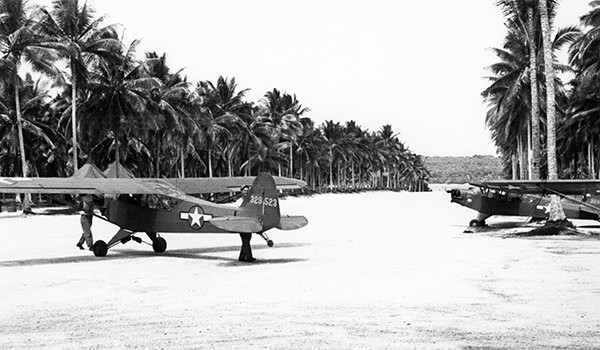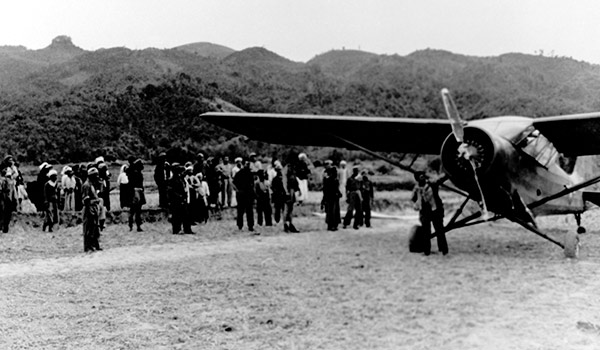
Historical Perspective / By Mark Albertson: This is Part II of a two-part series commemorating the 70th anniversary of V-E Day in World War II.

L-4 Cubs on Sandberg Field, Espiritu Santo, New Hebrides, 1943 / ARMY AVIATION MUSEUM COURTESY PHOTO
Combat conditions in the Pacific Theater differed from those in the European Theater. With the latter, the war was of the conventional type, replete with armor, artillery and infantry. While in the Pacific, Allied strategy was based on naval supremacy.
As the Pacific Fleet recovered from Pearl Harbor, the Island-Hopping campaign gathered momentum. Unlike the aforementioned conventional war in Europe, the approach in the Pacific amounted to Siege Warfare. Japanese island bastions not assaulted were bypassed, left to wither on the vine.
Jungle dominated much of the Pacific War; and therefore, impacted the use of artillery. “…where difficult jungle terrain was often encountered, flash ranging was found impractical… sound ranging provided an excellent means of locating Japanese artillery…”1
As in the European Theater, Cubs were found to have uses beyond their original intent. Being a rainforest, roads in New Guinea were rare and those available quickly became quagmires following heavy rains. Cubs were pressed into service as air taxis, hauling brass, delivering messages, moving supplies, shuttling wounded in addition to reconnaissance and patrols. Air operations were employed to direct counterbattery fire onto Japanese gunners shelling American barges moving supplies along the coast; and, conversely directing American artillery onto Japanese barges.
In this jungle nightmare, there was always something for Cub pilots to do. Captain Edwin Leer, a December 1942 graduate of Fort Sill, commanded a group of five L-4Bs: four sergeant pilots and himself. In less than three months in the New Guinea jungle, Leer and his fliers logged 956 hours.2
The forbidding topography of the Philippines compromised close air support for troops battling the stubborn Japanese. Cubs were thrown into action as pathfinders, dropping smoke grenades to mark targets for bombing or attack aircraft. In forty air strikes, this aerial combination resulted in no friendly fire incidents. Likewise Cubs were employed to lead C-47 pilots to their proper drop zones in the mountains so as to resupply troops on the advance. This enabled supply aircraft to better navigate the mountainous terrain and deal with the hazardous air currents.3
But Leyte was more than rugged mountains and hazardous air currents. Like New Guinea it was home to the ubiquitous jungle; a rainy, muddy, disease-ridden wallow in which American troops had to root out entrenched Japanese. Liaison pilots found themselves supporting their comrades-in-arms in this fetid wasteland. As noted by Major Edward M. Flanagan, Jr., FA, “it is the story of the overworked artillery air fleet doing a steam shovel’s job with a spoon.”4

Used in the Pacific, the Brodie Device was a unique approach to launching and recovering Cubs. / ARMY AVIATION MAGAZINE, NOV. 30, 2010
The impenetrable Leyte jungle restricted drop zones or clearings for C-47s to adequately supply troops. Not so flivver planes. At Manarwat, a field dug out of the jungle was able to handle Cubs. Aviators flew in sections of a portable hospital which was then constructed. Doctors saved the lives of many wounded, sometimes operating under flashlights. Some of the wounded were delivered to doctor’s care by Cubs; thereby avoiding time-consuming treks through the jungle.
From the division artillery air fleet, some nine Cubs and seven L-5s were put to work, delivering arms, ammunition and supplies to troops advancing in the Leyte jungles. At one point, flivver planes delivered 21 tons a day, in a performance that would herald the work of rotary wing aircraft and crews in Korea and Vietnam.
In the oft referred to, “Forgotten Theater” of war, the Army Air Forces was the primary employer of light aircraft. For instance, L-4s and L-5s were used to fly engineers in and out of construction sites during the laying of the Ledo Road – through northern Burma for the link up with the Burma Road, from Lashio to Kunming – the epic supply route to the hard pressed Chinese Nationalist forces.5
The L-1 [O-49] was found to be useful on the rugged Asian continent. While the C-47 proved valuable for its trips over the Hump, delivering supplies and evacuating wounded, the L-1 proved invaluable in local evacuations, its power plant able to hoist it above much of the area’s mountainous terrain. Conversely, liaison pilots braved hazards posed by the lower altitudes to airlift supplies, facing violent air currents which could send a flivver plane cascading out of control into a sheer mountain face or spiraling into the jungle floor below.
It was in the CBI that the first actual combat rescue by helicopter was flown by 2nd Lieutenant Carter Harmon, USAAF, April 26-27, 1944. Behind enemy lines in Burma, three wounded British commandos and a USAAF pilot awaited rescue. Liaison planes kept the unfortunates supplied for four nights. Harmon, meanwhile, had removed the co-pilot’s seat from his Sikorsky YR-4 so as to accommodate four Jerry cans for another 21 gallons of fuel. He took off from Lalagat, India, flying a route which included scaling a 6,000 foot mountain range. Harmon made four trips to extract those trapped.6
Yet even in that giant whirlpool known as war, there was the lighter side. “General Joseph ‘Vinegar Joe’ Stilwell, Commander of Tenth Army, used Cubs extensively during operations in Asia. He enjoyed riding with the Air OPs with the windows open. On one occasion he was being flown by SSGT. Lyle W. White on a mission off Okinawa. A gust of wind blew through the Cub’s cockpit and the general’s battered campaign hat – that he had worn for over twenty years – blew out the window. General Stillwell sadly watched his hat float down and plop into the sea. He remarked, ‘I’d sure like to go down there and rescue my old friend.’ Upon landing, Stilwell offered $25 to anyone who recovered his hat. Much to his delight, he was reunited with his old friend four hours later.”7
Notes
1. Page 253, “The Field Artillery Observation Battalion,” Prepared in the Department of Observation, the Artillery School, The Field Artillery Journal, Vol. 38, No. 6, November-December 1948, Prepared in the Department of Observation, the Field Artillery School.
2. Page 279, “Air OPs . . . in New Guinea,” The Field Artillery Journal, Vol. 34, No. 5, May 1944, by Captain Robert M. White, II, FA.
3. Pages 614-616, “Artillery Cubs in Mountain Operations: 33rd Infantry Div. in Northern Luzon,” The Field Artillery Journal, Vol. 35, No. 10, October 1945, by Colonel Ralph MacDonald, FA.
4. Page 73, “Biscuit Bombers (Leyte Style. ),” The Field Artillery Journal, Vol. 38, No. 2, March-April, 1948, by Major Edward M. Flanagan, Jr., FA.
5. Page 93, chapter 4, “Employment,” The Development of Organic Light Aviation in the Army Ground Forces in World War II, by Major Robert S. Brown, USA.
6. Page 9, “S-47/R-4 Helicopter,” Sikorsky Product History, prepared by Vinny Devine.
7. Page 170, chapter IV, “The War Years, Europe, Pacific and Korea,” The Army Aviation Story, by Richard K. Tierney with Fred Montgomery.
Mark Albertson is an award winning historian and contributing editor to ARMY AVIATION magazine.










